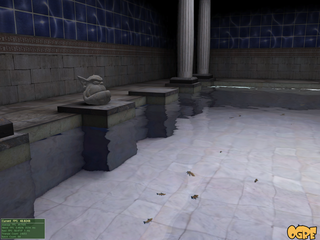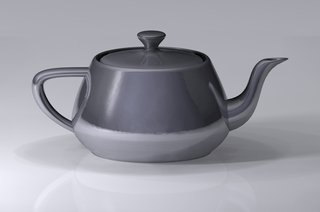Related Research Articles

Rendering or image synthesis is the automatic process of generating a photorealistic or non-photorealistic image from a 2D or 3D model by means of computer programs. Also, the results of displaying such a model can be called a render. A scene file contains objects in a strictly defined language or data structure; it would contain geometry, viewpoint, texture, lighting, and shading information as a description of the virtual scene. The data contained in the scene file is then passed to a rendering program to be processed and output to a digital image or raster graphics image file. The term "rendering" may be by analogy with an "artist's rendering" of a scene.

Computer animation is the process used for digitally generating animated images. The more general term computer-generated imagery (CGI) encompasses both static scenes and dynamic images, while computer animation only refers to moving images. Modern computer animation usually uses 3D computer graphics, although 2D computer graphics are still used for stylistic, low bandwidth, and faster real-time renderings. Sometimes, the target of the animation is the computer itself, but sometimes film as well.
In digital imaging, a pixel, pel, or picture element is a physical point in a raster image, or the smallest addressable element in an all points addressable display device; so it is the smallest controllable element of a picture represented on the screen.

Blender is a free and open-source 3D computer graphics software toolset used for creating animated films, visual effects, art, 3D printed models, motion graphics, interactive 3D applications, and computer games. Blender's features include 3D modeling, UV unwrapping, texturing, raster graphics editing, rigging and skinning, fluid and smoke simulation, particle simulation, soft body simulation, sculpting, animating, match moving, rendering, motion graphics, video editing, and compositing.

Texture mapping is a method for defining high frequency detail, surface texture, or color information on a computer-generated graphic or 3D model. The original technique was pioneered by Edwin Catmull in 1974.

Weta Digital is a digital visual effects company based in Wellington, New Zealand. It was founded by Peter Jackson, Richard Taylor, and Jamie Selkirk in 1993 to produce the digital special effects for Heavenly Creatures. In 2007, Weta Digital’s Senior Visual Effects Supervisor, Joe Letteri, was also appointed as a Director of the company. Weta Digital has won several Academy Awards and BAFTAs.

In signal processing, sampling is the reduction of a continuous-time signal to a discrete-time signal. A common example is the conversion of a sound wave to a sequence of samples.

In computer graphics, a shader is a type of computer program originally used for shading in 3D scenes, but which now performs a variety of specialized functions in various fields within the category of computer graphics special effects, or else does video post-processing unrelated to shading, or even performs functions unrelated to graphics at all.
Pixar RenderMan is proprietary photorealistic 3D rendering software produced by Pixar Animation Studios. Pixar uses RenderMan to render their in-house 3D animated movie productions and it is also available as a commercial product licensed to third parties.

Object-Oriented Graphics Rendering Engine (OGRE) is a scene-oriented, real-time, 3D rendering engine. The software is open-source. The first version of the software was released in February 2005. The software is written in C++.

3D rendering is the 3D computer graphics process of converting 3D models into 2D images on a computer. 3D renders may include photorealistic effects or non-photorealistic styles.

Peter Lang is an academic publisher specializing in the humanities and social sciences. It has its headquarters in Pieterlen and Bern, Switzerland, with offices in Brussels, Frankfurt am Main, New York City, Dublin, Oxford, Vienna, and Warsaw.

Complex is an American New York-based media platform for youth culture which was founded as a bi-monthly magazine by fashion designer Marc (Ecko) Milecofsky. Complex reports on trends in style, pop culture, music, sports and sneakers with a focus on streetwear, sneaker culture, hip hop, and graphic art. Complex reached over 90 million unique users per month in 2013, across its owned and operated and partner sites, socials and YouTube channels. The print magazine ceased publication with the December 2016/January 2017 issue.

3D computer graphics, or three-dimensional computer graphics, are graphics that use a three-dimensional representation of geometric data that is stored in the computer for the purposes of performing calculations and rendering 2D images. The resulting images may be stored for viewing later or displayed in real time.

3D city models are digital models of urban areas that represent terrain surfaces, sites, buildings, vegetation, infrastructure and landscape elements in three-dimensional scale as well as related objects belonging to urban areas. Their components are described and represented by corresponding two-dimensional and three-dimensional spatial data and geo-referenced data. 3D city models support presentation, exploration, analysis, and management tasks in a large number of different application domains. In particular, 3D city models allow "for visually integrating heterogeneous geoinformation within a single framework and, therefore, create and manage complex urban information spaces."

Computer graphics is a sub-field of computer science which studies methods for digitally synthesizing and manipulating visual content. Although the term often refers to the study of three-dimensional computer graphics, it also encompasses two-dimensional graphics and image processing.

Computer graphics is the discipline of generating images with the aid of computers. Today, computer graphics is a core technology in digital photography, film, video games, cell phone and computer displays, and many specialized applications. A great deal of specialized hardware and software has been developed, with the displays of most devices being driven by computer graphics hardware. It is a vast and recently developed area of computer science. The phrase was coined in 1960 by computer graphics researchers Verne Hudson and William Fetter of Boeing. It is often abbreviated as CG, or typically in the context of film as CGI.

Katie McGrath is an Irish actress. In television, she is best known for portraying Morgana on the BBC One series Merlin (2008–2012), Lucy Westenra on the British-American series Dracula (2013–2014), Sarah Bennett in the first season of the Canadian horror anthology series Slasher (2016) and for her role as Lena Luthor on the American superhero series Supergirl (2016–present). Her film roles include Lady Thelma Furness in the drama film W.E. and Jules Daley in the Christmas movie A Princess for Christmas, (2011), Zara in the science fiction adventure film Jurassic World (2015) and Elsa in the epic fantasy film King Arthur: Legend of the Sword (2017).

In 3D computer graphics, 3D modeling is the process of developing a mathematical representation of any surface of an object in three dimensions via specialized software. The product is called a 3D model. Someone who works with 3D models may be referred to as a 3D artist. It can be displayed as a two-dimensional image through a process called 3D rendering or used in a computer simulation of physical phenomena. The model can also be physically created using 3D printing devices.
Foveated rendering is a rendering technique which uses an eye tracker integrated with a virtual reality headset to reduce the rendering workload by greatly reducing the image quality in the peripheral vision.
References
- ↑ Mandelbaum, Ryan F. "Just Look at This Freakin' CGI Fur". Gizmodo. Retrieved 2019-12-25.
- ↑ Ebiri, Bilge (2019-08-06). "Digital Fur, Digital Folks: Reality Is Starting to Feel Overrated". The New York Times. ISSN 0362-4331 . Retrieved 2019-12-25.
| This film-related article is a stub. You can help Wikipedia by expanding it. |